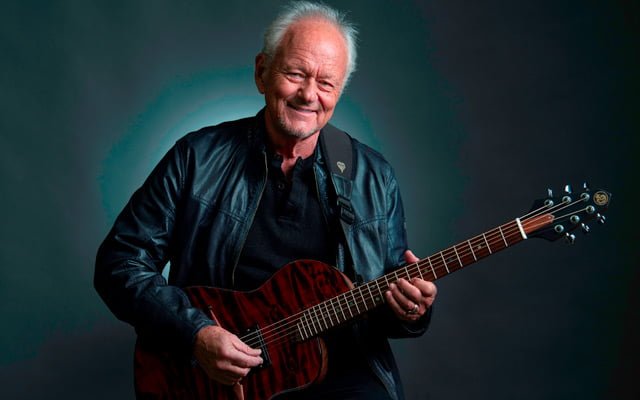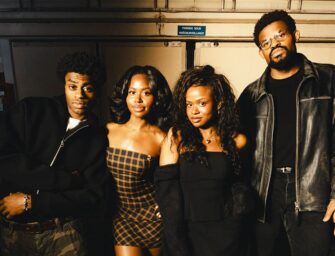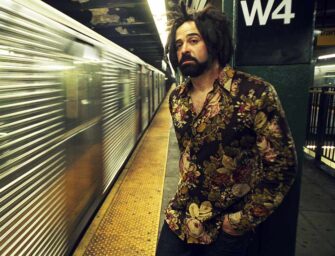
Jesse: “One of the triggers would be a chord progression that I’d never used or heard before…” Photo: Brent Cline
Emerging with his first new record in over a decade, the ex-Youngbloods frontman has rediscovered all of his songwriting magic
As the frontman of The Youngbloods, whose version of Get Together remains one of the best examples of the unifying power of song, Jesse Colin Young experienced life in the centre of the mid-60s peace movement. Upon leaving the group in 1972, Young launched a solo career which continues to this day. A particular favourite of ours is his 1973 album Song For Juli, which demonstrates his ability to blend genres while also maintaining a constant thematic thread through an entire record. Plus, its opening track Morning Sun is truly joyous.
Young recently returned with his first new studio album in 13 years, Dreamers. With his son, Tristan and Colin Linden on production duties, and some writing help from his wife Connie, the record finds him re-energised and once again utilising that ability to bring together styles such as country, folk, jazz, blues and rock into a coherent statement.
We recently spoke to Jesse about his incredible career and how Dreamers came together…
Was there a specific incident which made you think that the time was right to work on a follow-up to Celtic Mambo?
“I was diagnosed with Lyme disease in 2009, I’d probably had it for 20 years before that. I had to take some time off and get better and it was a slow process. Then, in 2016, my son Tristan was graduating from Berklee College of Music and I went to his senior recital. He had put together a little band and I just sat there and they blew me away. I immediately thought, ‘I want to play with young people like this’. So when we got an invite to SXSW, I asked Tristan if he would put a band together and he brought forward all these wonderful musicians.
“After the first five shows, I knew that I wanted to record with them. So we toured for about a year and worked on the new material. I worked on writing it. Connie and I wrote a couple of the songs together, including Cast A Stone which opens the album. When we wrote that it came so quickly I think I knew that I was getting better, because there weren’t many songs in the years before that.”
So you hadn’t been able to write at all during that time?
“Some songs, but usually topical songs. I decided to do these little acoustic videos. For the first we made, which was called My Hometown, my Labrador, Django, came and curled up at my feet. It was a one-camera video, very simple. Then whenever I wrote a song over the next three or four years, I would go in and tell Django, ‘It’s time to work,’ and he would come and curl up at my feet and stay there. So yes, maybe there were three or four songs over that period, but that was it.”
Did you have one set way of making it happen once you’d rediscovered that desire to write, or would it change depending on the song?
“It’s really a song-by-song process. One of the triggers would be a chord progression that I’d never used or heard before. If I sit down in the morning and just play and don’t think about it, sometimes those things occur and I make little recordings of them and then come back to them and write lyrics. Sometimes it’s an idea. I wanted to write something about how much lying there is on television, so that came first, and Shape Shifters the title probably came to me and I just worked on it as a song until it came out. Then sometimes I would get a line. Yesterday I had a bunch of lyrics in a book that I have not yet put music to.
“Lyrics sometimes come, and I just write everything down. Then when I read them the next day most of it is kinda lame but there’ll be a few gems in there and so I will pull the gems out. I really have no control over that and I don’t want to. With this record, because time became short and I was three or four songs down, I had to get up every day open up my hands to the heavens and say, ‘I’ll take some inspiration now please,’. And it kind of worked.”

Jesse Colin Young: “I do my best to create a path but then things change…” Photo: Brent Cline
One of the things that struck us about Dreamers is how diverse the genres are. Does the song lead you in a certain direction or is it less spontaneous than that?
“There was no planning there. For example, I knew I wanted to write a song about the environment but I had no idea that it would come as a Cajun waltz. At the beginning, I thought that was peculiar, but that’s the way it came and I got Connie to help me with that because I got stuck. I think the theme of what I’m writing about in some ways dictates the musical style. They’re all styles that are natural to me, in my life I’ve used them all so they’re all part of me. They come out in one direction or another and I seldom change that.”
Is there a shared essence, no matter what the style?
“Well, there’s a lot of topical song on this. I didn’t plan that but there’s a lot of disturbing things going on in the United States, politically and socially. I’m sure that had a big influence. There are three love songs. Some songs were pushed aside as not really fitting in with the group, but in some ways, it just happened and we were able to make. Then, when we started listening to it, had we came up against something that was either lame or didn’t fit anywhere I think we would have pushed it aside.
How much say did the band have in the direction of the songs?
“We rehearsed them all and anyone could have an idea when we were doing that. I do my best to create a path but then things change and we come upon parts that I thought were cool, playing by myself, that don’t really fit or are awkward with the band, so everyone was involved in that.
“When we went in to record we didn’t change a lot of the structures, we were pretty settled and we wanted to be. We recorded most of this live, not the background singers but everyone else. I had a little room so I could play acoustic guitar, Tristan was out playing bass with the drummer. The keyboard player was direct and the same thing with the guitarist. We picked Sound Emporium Studios because they had one room where I could see everyone. We were going for magic and we had our tunes formed and had done our work with them. I have a squash court in South Carolina and we have a little recording set-up there, so we could listen and make sure we were headed in the right direction.”
What effect did working with those young musicians have?
“Well, they’re just so good. They have so much energy and are such fine musicians. That’s what blew me away, the energy. The album has a lot of energy and part of that belongs to them. I noticed that when I play with them live, the energy of the band would lift me up and I’d come off stage and feel like I was 40. We kept the tapes that were the most magical or the most powerful and Tristan was involved in a lot of the work with the producer, Colin Linden, to keep the magic and patch up the mistakes.”
What was the working relationship with Colin like? What did he bring to the songs?
“Well, he played on almost everything. And his playing added another energy. He’s always been a big Jesse Colin Young fan, this had always been one of his dreams and so there’s all this, ‘Oh boy, aren’t we lucky to do this together,’ that we could afford this and do it in this beautiful studio. Colin and Tristan got very close and worked on a lot. That really freed me to just perform, sing and go after it – whether a rhythm guitar track or whenever I felt like singing.”

Jesse Colin Young: “I really don’t like to bear down and play a song over and over.” Photo: Brent Cline
You weren’t tempted to produce this one yourself?
“No! I’m done with that. I can’t mix my own albums anymore either, my hearing’s not good enough. I was able to let go of that, I knew I needed a producer. Colin was brought forth by a fellow who used to be my agent. He knew I wanted to record in Nashville and thought about who would be a good producer for me, the first person he settled on was Colin because he comes out of the blues so strongly. He’s a wonderful guy, he has a great personality.
“He reminds me of Charlie Daniels who produced Elephant Mountain, for The Youngbloods. Colin did a beautiful job and I think Tristan really helped. Each time Colin had his stuff there – his pedal boards and dobro and Mandotar – he’d say, ‘Gee I’d like to play on this one,’ and then on the next one, he’d say the same. He kept the energy focussed, he’s such a tasty player and he’s a one-pass wonder!
“I really don’t like to bear down and play a song over and over. A couple of times through and I’m on my way to being really bored. I think because we had spent the right amount of time crafting their shape we could just concentrate on the magic.”
It would be remiss of us not to ask a couple of questions about the early days… How much do those experiences still inform your writing?
“They call those the formative years. Alan Freed, a disc jockey in New York came on the radio when I was 10. There was a lot of doo-wop back then and all of a sudden we got Fats Domino, Little Richard and eventually Elvis. I used to leave my radio on all night, turned way down low so my parents couldn’t hear it, but it was right in my headboard a foot from my head. Then I fell in love with folk music and found the blues and then it started to click. When I discovered T-Bone Walker, I thought ‘Elvis has been listening to the blues.’ He was the one that brought it anyone who was never exposed to any roots blues. Then there was folk music.
“All of that connected and formed me. The first recording I ever made was at prep school, they had a machine where you could cut a one-off record and I recorded Trying To Get To You and then I started writing my own music when I was 15, being locked away in the Monastic boys school that I was attending, and that’s where I learnt to play the guitar.”
How important has Get Together been for your career?
“Get Together changed my life. When I heard it at an open mic in The Village, I was in The Youngbloods. We would rehearse every day that we could at the Café Au Go Go, every day that it was empty in the daytime. I walked in there one afternoon, thinking it might be open for rehearsal and there was a fellow named Buzzy Linhart singing Get Together on stage. I had seen Buzzy play vibes with Tim Hardin, but I didn’t know he was a singer. I ran backstage and said, ‘Please, I need the lyrics. I’m in love with this song, I’m going to sing it,’ and I knew it would change my life and I knew it would be central to my career and my development as a human being. It was that powerful.
“Maybe that’s why it was The Youngbloods version, my devotion to that song, that helped it to become the pure record that it is. There was no pressure to make a single out of that. Nobody had any idea that that would be so big, they left us alone to make a piece of audio art and we got lucky. It never would have been a hit if the country hadn’t of been going through what it went through – it was the right time and the right song.”
And it’s still an important part of your life?
“It’s funny, I played in Greenwich Village with Tristan and our drummer Donnie Hogue at this free concert in Central Park that they do all summer. About 6000 people came. It was not the usual audience that I would have in a smaller venue, they were younger and they sang Get Together and they sang it stronger than I have ever heard it sung in my career. It shocked me. I saw some people raising their fists while singing and I thought, ‘Wow, what’s going on?’ After the show, I realised that it was the one-year anniversary of Charlottesville and those people were saying no to white nationalism and saying yes to peace and love. It blew me away.
“The power of that song has never diminished. Sometimes I think that’s why I came out of my quasi-retirement, I didn’t know whether I was physically ready for this or not but I felt like I had to do it. I wanted to play with these young people and then I realised I wanted to record with them and sing Get Together again – along with all this great new material.”
Dreamers is out now on BMG. For all the latest news, head over to jessecolinyoung.com







![Interview: Jessie Jo Dillon [2025]](https://www.songwritingmagazine.co.uk/wp-content/uploads/jessie-jo-dillon-2-by-libby-danforth-335x256.jpg)
























An excellent commentary and introduction sets this interview up perfectly. So glad to hear these rich stories from Jesse and thoughtful reasons for life’s events bringing his wonderful music back to us again. Cant get enough.